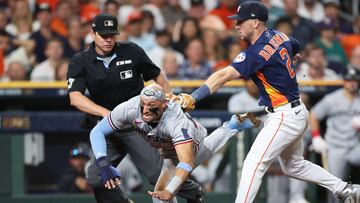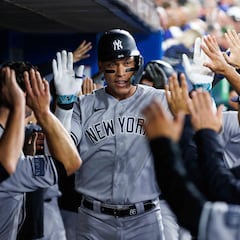MLB rule changes for 2023: The shift, pitch clock, pickoffs, bigger bases, etc.
Major League Baseball implemented significant rule changes, including a pitch timer, larger bases, and limits on defensive shifts for the season 2023.


There is an old adage that men get married thinking women won’t change, and they will. While women get married thinking that men will change, and they won’t.
I know that might be a steep leap to baseball, but stick with me for a second. One of the most comforting things about baseball is its constancy. That is what made, and still makes, Field of Dreams such a resonant film. Baseball is constant.
“America rolls by like an army of steamrollers. It’s been erased like a blackboard, rebuilt, and erased again. But baseball has marked the time.”
James Earl Jones as Terence Mann in Field of Dreams
But Rob Manfred has taken baseball by the throat and shaken the game so violently that it is almost unrecognizable to the game that so many of us played all our lives. He has been almost universally hated for it, but the changes keep washing over our beloved game.
Conceived as a way to make casual fans, or even non-fans, happier with watching baseball and ultimately spending their money on MLB tickets and merchandise, these rules fundamentally alter the game into something else entirely.
The most visible is the institution of the pitch clock, the first time in history that time matters in a baseball game. Sacrilege.
Mets’ Adam Ottavino confident he can quicken pace under MLB’s new rules https://t.co/AkH48pGoEV pic.twitter.com/42J7pMeoJb
— New York Post Sports (@nypostsports) February 14, 2023
But it doesn’t end there. The bases are also bigger; the infield requires two players on each side of the second base and all four with their feet on the dirt when the ball is pitched, and the pitcher is limited to only two pickoff attempts.
Let’s look at them all one by one.
Banning the infield shift
What was new?
When a pitch is thrown, all four infielders must have their feet on the infield dirt (or demarcated infield grass if there is no dirt) and position two players on each side of second base. Players may move as soon as the ball leaves the pitcher’s hand so they can run toward a shift position.
Enforcement
The game proceeds if the batter reaches base and all runners advance on a ball hit with the infield in an illegal position. If the batter or any baserunner is put out on the play, the team may accept the penalty, which would award the batter a ball to his count, or decline the penalty and allow the play to stand.
Allowing the infielders to move after the pitch is delivered is a paper tiger, giving the appearance of offering the possibility of setting your infield without actually doing anything. It is a lawyer’s trick, a favorite of politicians, and utterly unworkable. Anyone with even a modicum of baseball sense can see this.
Pitch clock
What is new?
Pitchers are allowed 15 seconds to throw a pitch with empty bases and 20 seconds with a runner on base. Batters must be in the batter’s box and ready with eight seconds on the pitch clock.
Enforcement
If a pitcher has not started “the motion to deliver a pitch” before the clock’s expiration, he is charged with a ball. If a batter is not deemed in the box and ready, he is charged with a strike.
Much still depends on the umpire’s interpretation of “pitcher’s motion” and in the box “and ready.” There is no question that there has been much abuse in college and minor league baseball by umpires who have called a ball mid-windup or given strike three because the batter was wiggling his bat as he waited for the pitcher. Maybe the umpire was hungry or wanted to finish the game so they could go home. Who knows? All that can be said with any certainty is that this rule was certainly abused by an MLB umpiring corps who like to assert their authority over a game.
Pickoff attempt limit
What is new?
Pitchers are now allowed to disengage with the rubber twice per plate appearance. This number resets if a base runner advances within the same plate appearance.
Enforcement
A third step-off result in a balk unless at least one offensive player advances a base or an out is made on the ensuing play.
This is an attempt to bring back base stealing to the game. Since the analytics takeover of MLB in the mid-2000s, stolen bases have been down dramatically. Players like Rickey Henderson, Ozzie Smith, or even Ichiro are an anachronism in today’s game, where teams focus almost exclusively on home runs and dare not risk an out by letting a speedy runner stretch his legs.
Bigger bases
What is new?
The size of the bases is increased from 15 inches to 18 inches square.
The idea was to reduce injury around first base, where runners consistently refuse to run in the running lane. Instead of simply enforcing the existing rule and calling the base runner out, the league has taken a hammer to crack a walnut. While the media focuses on how the base paths will be three inches shorter than before, the truth is that this rule change had negligible to no effect whatsoever on the game.
Limits on position players pitching
What is new?
Teams need to be up by ten or more runs, while the trailing team would need to be down by eight or more to allow a position player to take the mound.
This one is tricky to unstitch because it has required a completely new rule to be invented to accommodate Shohei Ohtani. One of the great things about baseball is that the rules are traditionally the same from Little League to the Show. For kids, grabbing your shortstop or center fielder to pitch a few innings is customary and even makes sense if he has a strong arm. Kids all play both ways.
MLB announced plans to extend new rules for position players pitching into the 2023 season. pic.twitter.com/yQWshyOCMZ
— FOX Sports: MLB (@MLBONFOX) February 13, 2023
Professionals, however, specialize. It is in their interest to be the best at one specialty rather than to spread themselves too thin. And it benefits the team and the league as well. Every once in a while, you get a player like Ohtani to come along, a guy who still plays like he’s in Little League, in the sense that he has one of the best bats and gloves on the team while being a great pitcher, too.
The real problem is when it comes to money. Numbers, both offensive and defensive, are what salaries are based on. If a team wants to save a bullpen arm and stick their left fielder on the mound to finish out a stinker of a game, the offensive production will undoubtedly go up without question or exception. This could artificially inflate offensive numbers throughout the season, making them an unreliable metric for salary negotiations or arbitration.
Which of these new rules were necessary for baseball?
The short answer is none. Baseball is just fine the way it is, the way it has been played for two centuries now. There is nothing inherently special about today’s fans, younger generations, or even modern audiences that makes any change at all necessary. But some of these are more sensible than others.
The base size and position players’ rules will likely go unnoticed, so the question for those new rules should be “why not” rather than “why.”
The shift ban and pickoff limits will undoubtedly be the most visible of the new rules, and both will fundamentally alter the game. Lining up in a pre-set position is offering a reward for lousy hitting.
And all the people who talk about how it is impossible to adjust where and how you hit the ball have never played, or they were the worst on their Little League team before they quit. For those who have played at a reasonably high level, dealing with an overshirt is not inordinately challenging. Yes, it takes discipline and willpower, but it can be done.
In its infinite wisdom, MLB has decided to reward hitters who are too lazy to alter their approach and make out as if the defense is somehow cheating by standing where they know, not think, but know, that this bone-idle layabout will hit the ball.
Hi, just dropping in to let everyone know that moments like this are going to be impossible with the MLB pitch clock. pic.twitter.com/qSevnL6brd
— Miguel Cabrera’s Bat (Benson) (@Miggysbat) March 22, 2023
But if you had to pick one of these idiotic changes to eliminate, one that makes no sense, it would have to be the pitch clock.
No longer will the pitcher be delivering his best pitch to the batter. He will be providing the best that he can muster right now. Ditto the hitter. He won’t be in the correct head space for the pitch; it’s the best he can do in eight seconds. It is akin to speed chess; you won’t be watching grand masters at work anymore, just hustlers.
Related stories
MLB said they wanted to eliminate “dead time” between pitches, but that is not what this is. This fundamentally alters the very fabric of the game. You can’t “save” baseball by turning it into another sport any more than you can save Star Trek by turning it into Star Wars. Different fans watch different sports for various reasons, and if you undermine baseball to win over NFL or NBA fans, you wind up with no fans.
The pitch clock is an abomination and needs to be dropped immediately.

